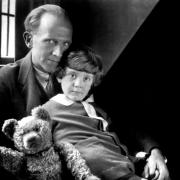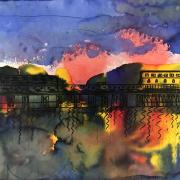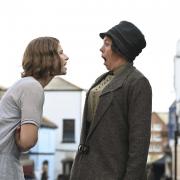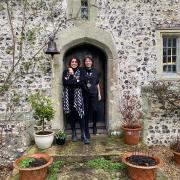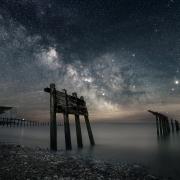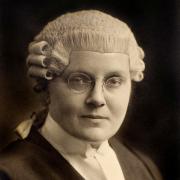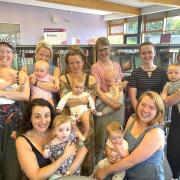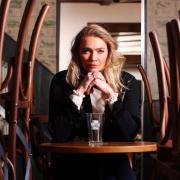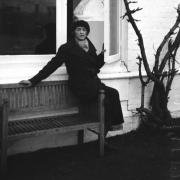Children’s Laureate Chris Riddell is exhorting children to do something creative every day, via his daily doodles on the Book Trust’s website. He is also a political cartoonist for The Observer and a passionate defender of public libraries. Nione Meakin found out more

Chris Riddell has nearly been caught a few times. Furtively sketching on a train to or from one of his many engagements, his subjects will sometimes wake up, or catch his eye, and he’ll have to put down his pencil. So far, no one has recognised the quiet, burly man behind the sketchpad as the current Children’s Laureate – and that’s just the way he likes it.
Like his predecessor Quentin Blake, who was the first to hold the post back in 1999, Riddell is identified by his drawing style more than his person. The illustrator’s meticulous lines, rich in texture and detail, are as singular as Blake’s energetic dashes when spotted in the pages of The Observer, for whom he works as a political cartoonist, on the cover of his many bestselling young-adult fantasy novels or on Twitter, where his drawings say more than 140 characters ever could.
His elegant draughtsmanship is coupled with a ferocious imagination that allows him to travel from the corridors of Whitehall to the only slightly stranger terrains of ‘Muddle Earth’ in a few pen strokes, and to turn his hand from gentle humour to eerie Gothic, much like his former Brighton University tutor Raymond Briggs, creator of Christmas classic The Snowman and chilling nuclear war satire When The Wind Blows.
Even before Riddell took up the Book Trust’s laureateship – which recognises an eminent children’s writer or illustrator – he was much in demand. If he wasn’t exhausting his black ink on illustrations for fantasy behemoth Neil Gaiman, with whom he worked on Coraline, The Graveyard Book and The Sleeper and The Spindle, he was in the studio completing new additions to his bestselling Ottoline and Goth Girl books. Or sniggering at his visual manifestations of silly puns (see: The Da Vinci Cod; The Apes of Wrath). Or drawing dozens of rats for Trickster’s Tales – Russell Brand’s first foray into children’s writing. “He was a complete blast,” says Riddell, whose drawing of their working relationship depicts the illustrator awkwardly enveloped in the comedian’s bear hug. “Underneath the showbiz veneer he’s a very decent person and a lovely man.”
When we meet at the Victorian home Riddell shares with his illustrator wife Joanna Burroughes and their three grown-up sons in Brighton’s Preston Park, he is simultaneously working on his weekly cartoon for The Observer, a new illustrated version of Lewis Carroll’s The Hunting of The Snark; the fourth Ottoline book; the concluding novel in fan favourite The Edge Chronicles, and Odd and the Frost Giants, another collaboration with Gaiman. Oh, and an anthology of poetry – although not his own, he’s quick to add, because it would certainly appear a possibility.
He thinks it is important to be seen as a working writer and illustrator in the laureateship, which is one of the reasons he also pledged to keep a public drawing diary throughout his two-year tenure. His daily posts, uploaded to the Book Trust’s website, form a charming record of his days. There are love-ins with his peers at the Children’s Laureate reception, days in the studio watched over by his bust of William Blake, wanders through leather-bound libraries and of course, pictures of his fellow train passengers. Riddell’s dashed-off doodles are a far cry from what most of us could achieve in 15 minutes but aiming for perfection is very much Not The Point. In these days of targets and attainment levels, he feels children are in danger of overlooking the joy of putting pen to paper for no reason at all. In his scribble-along book A Doodle A Day, published last year, he suggests readers start by simply finding every pen and pencil they can and trying them all out on the page. “Drawing is fun, it’s the best thing, but the joy of it can be leeched away through it being taught in a certain way, or by kids deciding they can’t draw. I want kids to forget all that, and just draw.”
He feels the same about reading and is a devoted advocate of public libraries. He and writer Paul Stewart even made librarians the heroes of The Edge Chronicles. Varis Lodd, he writes, “is prepared to put her life on the line to defend the Great Library”. Riddell hasn’t gone quite as far as that but he’s clocked up a fairly heroic number of school library visits and public talks to extol the lifelong delight of reading for pleasure. “People wring their hands about literacy and the drop in numbers of kids visiting libraries but if children don’t read, it’s because at primary level reading for pleasure isn’t pushed. It’s all about exams and being made to read. Why can’t a teenage boy play football and Playstation, and have a novel on the go? He can. But if you’re trying to pull him off the football field aged 15 to force him to read Dickens, you’re catching him too late.”
Riddell is not there to “wag a finger”, he points out. He prefers to focus on solutions rather than problems, to champion enthusiasm over disgruntlement. But, “I’m not going to shy away from politics as Children’s Laureate.” His belief in the sanctity of the Human Rights Act led to My Little Book of Big Freedoms, a collaboration with Amnesty in which he illustrated a different point from the Act in a child-friendly way. Last year he worked with fellow Sussex writer Nicky Singer on Island, which explores the impact of global warming through a boy-meets-girl-meets-polar bear story. Numerous publishers turned it down on the basis that it was too complex, too serious, for children – which was all the more reason to publish, in Riddell’s eyes. “The world can be a dangerous place and I don’t think any parents want to fill their children with anxiety and fear, so the way to talk about issues is to talk about what we hope for and to reinforce a sense of what can be better.”
For now, however, he’s focused on rather less controversial matters. He has visits to Wales and Northern Ireland, a Scottish book tour, The Big Draw campaign in the autumn and a spell as illustrator-in-residence at Seven Stories, Newcastle’s National Centre for Children’s Books. Before any of that though I’m relieved to hear he’s off for a well-earned family holiday in Norfolk, sketchbook in hand.
Chris Riddell picks his five favourite children’s books
• The Hobbit, J.R.R. Tolkien - “The Hobbit had a huge influence on me when I read it as a ten year old. There are so many layers, from Tolkien’s characterisation to the imaginary world he conjures. He was a fantastic nature writer. It’s sometimes overlooked but he writes beautifully about landscape. It’s a landscape of his imagination but also the one he experienced growing up, all transposed to this complete world.”
• The Catcher in the Rye, J.D. Salinger - “Although it was originally intended for an adult audience, these days you might describe this tale of teenage angst and alienation as a classic young-adult novel. It was certainly a transitional book for me when I read it aged 15. I really identified with the protagonist Holden Caulfield and the book became incredibly significant to me when I was growing up. I still go back to it from time to time.”
• Wuthering Heights, Emily Bronte - “Wuthering Heights was a book I wouldn’t necessarily have read had I known what it was about – I suppose I’d have thought it was aimed at girls – but I picked it up and became hooked. When you become a reader as a child you develop an expectation that books are interesting things that you’ll get something from. Wuthering Heights reinforced my feeling that there was wonderful stuff out there that I would find sometimes by accident, just because I read.”
• A Midsummer Night’s Dream, William Shakespeare. 1914 edition illustrated by W. Heath Robinson - “Shakespeare can be a hard sell for kids but look at a book like this and I defy anyone not to want to know what the story is about and to explore it further. Heath Robinson’s illustrations are all in black and white but they are the most amazing images – they made Shakespeare seem magical. For me this is an example of the way words and pictures together can draw you in to something that might be considered difficult or challenging.”
• A Wizard of Earhsea, Ursula K. Le Guin - “This 1968 fantasy novel, set in a land of dragons and shadowy beings, was a huge influence on me, and especially when I began working on The Edge Chronicles in 1998. The story of a young sorcerer in training, Le Guin’s book laid the ground for Harry Potter and Game of Thrones and introduced young readers like me to big ideas about power and mortality.”
READ ON
• Artist Helen Wells and her Victorian home in Hastings - Artist Helen Wells and her husband Mark moved to Hastings from London just eight months ago. They have certainly put their stamp on their five-storey Victorian home, finds Nione Meakin
• Peter James: Being recognised and an amazing visit to the Maldives - Bestselling crime writer Peter James talks us through his gastronomic adventures and keeps us abreast of everything relating to his fictional detective, Roy Grace




